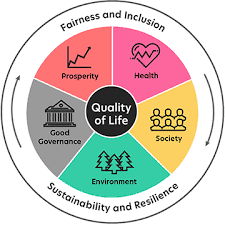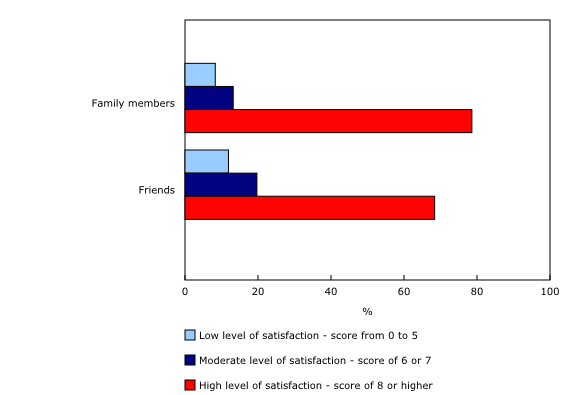Relationships with family, friends and neighbours are essential in developing a strong sense of identity, belonging and personal safety. Similarly, trust in family and friends and societal institutions can be important to building and maintaining social ties. Trust is associated with higher levels of reciprocity and cooperation between individuals, and can facilitate the flow of information and transactions. This, in turn, can affect the overall performance of the economy.

In 2023, most Canadians reported high satisfaction and trust in their relationships. On the other hand, they reported some distrust of information and news from the media, particularly from non-traditional sources, such as the Internet and social media.
“Trust in others” and “satisfaction with personal relationships” are two indicators from Canada’s Quality of Life Framework. This analytical framework helps the federal government identify future priorities by collecting essential data on the well-being of Canadians.
About 8 in 10 people have a high level of satisfaction with relationships with their family members
In 2023, the majority of Canadians expressed a high level of satisfaction in their relationships, namely family members and friends.
Overall, 79% of Canadians said they had a high level of satisfaction with their relationships with family members, meaning that their satisfaction score was 8 or higher on a 10-point scale. The corresponding proportion for friends was 68%.
No significant differences were found between women and men; however, satisfaction with relationships gradually increased with age. Individuals aged 65 and older had the highest overall level of satisfaction, with more than two in three people in this age group (67%) having a high level of satisfaction with both family members and friends. In contrast, 55% of young people aged 15 to 24 said the same.
The difference in the level of satisfaction between these two age groups was mainly attributable to the satisfaction of older people with their family members. A total of 85% of people aged 65 and older expressed satisfaction with relationships with family, compared with 70% of those aged 15 to 24. However, both groups had similar proportions for friends (72% of people aged 65 and older versus 70% of those aged 15 to 24).
Seniors have more trust in others
Trust in others can facilitate interpersonal relationships and promote cooperation between individuals. A higher level of trust in others not only has benefits for individuals but also for society as a whole, with greater overall social cohesion.
Overall, almost 3 in 10 people (28%) said they had a high level of trust in others. In other words, they assigned a trust score of 8 or higher to at least three of the following four groups of people: family, friends, neighbours and strangers.
As expected, the level of trust in others depended to a large extent on the type of relationship between individuals. In particular, most people expressed a high level of trust in loved ones, namely, family members (89%) and friends (70%). However, they were less likely to report a high level of trust in their neighbours (30%), and even fewer said they trusted people they did not know (4%).
Trust did not vary by gender, but did vary by age. Individuals aged 65 and older (39%) were almost twice as likely to have a high level of trust in others as young people aged 15 to 24 (20%). The difference between these two age groups was mainly attributable to the level of trust in neighbours, which was significantly higher among those aged 65 and older (43%) than among those aged 15 to 24 (22%).
Canadians are more likely to use the Internet, television and social media to get information
Like trust in others, trust in major Canadian political, economic and legal institutions is essential to the country’s well-being. The same is true of trust in the information that Canadians consume through the media.
In 2023, the majority of Canadians got their news and information from the Internet (33%), television (28%) or social media (24%). A smaller proportion of the population preferred getting news and information through the radio (8%), print media (5%) or other sources of information (2%).
Young people were more likely than seniors to use the Internet and social media to obtain information, with seniors preferring more traditional media sources, such as television, radio and print media. The majority of young people aged 15 to 34 (85%) reported getting news or information from social media (48%) or the Internet (37%). A significant proportion of the population aged 35 to 54 also preferred to get information through the Internet and social media (65%). Among those aged 65 and older, television was by far the primary source of news and information (63%). Fewer than one in five people aged 65 and older preferred the Internet (16%) or social media (3%) to get information.
Canadians trust information and news from television, radio and print media more than information and news from the Internet and social media
Generally speaking, the Canadian population expressed some distrust of the media. Fewer than one in six people (16%) reported a high level (score of 8 or more) of trust in information and news from the media. Most individuals reported a low level (score of 5 or less) of trust (53%) or a moderate level (score of 6 or 7) of trust (32%) in the media as a whole.
A low level of trust in the media may at first glance seem worrying. However, a low level of trust in a source of information that is not always trustworthy or a source whose information has become less accurate over time is not a wholly bad sign, if it indicates that the public remains cautious and critical of the information it receives.
This is reflected in the results obtained by media type. A smaller proportion of the Canadian population had a high level of trust in information and news from the Internet (13%) and social media (5%), despite their greater popularity, particularly among young people. In contrast, traditional media—television (28%), radio (28%) and print media (28%)—were much more likely to be trusted, and this was true for all age groups.
Overall, those aged 65 and older trusted the media more than their younger counterparts. They were almost twice as likely as those aged 15 to 24 to have a high level of trust in the media as a whole (22% of those aged 65 and older compared with 12% of those aged 15 to 24) and had a higher level of trust in information and news from television (37% compared with 24%) and radio (33% compared with 22%).
People’s high level of satisfaction with personal relationships is linked to a high level of trust in others
People’s level of satisfaction with personal relationships, as well as the level of trust in people they know and information from the media, is strongly correlated with other dimensions of life, such as life satisfaction and mental health.
For example, 75% of those who reported a high level of life satisfaction (i.e., a score of 8 or above on a 10-point scale) also had a strong sense of satisfaction with their relationships with their family and friends. By comparison, this same proportion was 45% among those who reported a lower level of life satisfaction (i.e., a score below 8 on a 10-point scale).
People’s satisfaction with their relationships was also related to their mental health. Those who reported having excellent or very good mental health (75%) were more than twice as likely to have a strong sense of satisfaction with their relationships with family and friends, compared with those who reported having fair or poor mental health (34%). Similar results were observed in terms of the level of trust in others and the media about mental health and life satisfaction.
In addition, those who reported a high level of satisfaction with personal relationships were more than four times more likely to have a high level of trust in others (40%) than those who reported a lower level of satisfaction (9%).
Similarly, those who expressed a high level of trust in others (23%) were more likely to trust information and news from the media than those who expressed a lower level of trust in others (13%).

Note to readers
The CSS collects information on a variety of social topics, including health, well-being, impacts of the COVID-19 pandemic, changes in the household, work–life balance, time use, intentions to have children and changes in marital status. The most recent cycle of the CSS, on which this release is based, collects information on quality of life, virtual health care, electronic health information and trust in media.
Satisfaction with personal relationships was measured by the following question: On a scale from 0 to 10, where 0 means “Not at all satisfied” and 10 means “Completely satisfied,” how satisfied are you with your relationships with a “group of people”? This question was used to measure the level of satisfaction with two groups of people: (1) family members and (2) friends. In this release, those with a strong sense of satisfaction with personal relationships are those who selected a score of 8, 9 or 10 in the previous question.
Trust in others was measured by the following question: Using a scale of 0 to 10, where 0 means “Cannot be trusted at all” and 10 means “Can be trusted completely,” what is your level of trust in a “group of people”? This question was used to measure satisfaction with four groups of people: (1) family members; (2) friends; (3) neighbours; and (4) strangers. In this release, those with a strong sense of trust in others are those who selected a score of 8, 9 or 10 in the previous question.

Trust in the media was measured by the following question: On a scale of 0 to 10, where 0 means “Not at all” and 10 means “Completely,” to what extent do you generally trust the news or information you receive from a “source of information”? This question was used to measure the level of trust in five sources of information: (1) the Internet, other than social media; (2) social media; (3) television; (4) radio; and (5) print media. In this release, those with a strong sense of trust in the media are those who selected a score of 8, 9 or 10 in the previous question.
Those who expressed a high level of trust in “everyone” are those who reported a level of trust of 8 or higher for at least three of the following four groups of people: family members, friends, neighbours and strangers. Please note that the estimates for the “Trust in everyone” category are not comparable to those for “trust in people,” calculated from the data from waves 5, 7 and 9 of the CSS.
Results were broken down by racialized population group, Indigenous identity and immigrant status. However, the results were not presented because of the small sample size or high variability.






daxktilogibigibi.MTQYiIcYnKzy